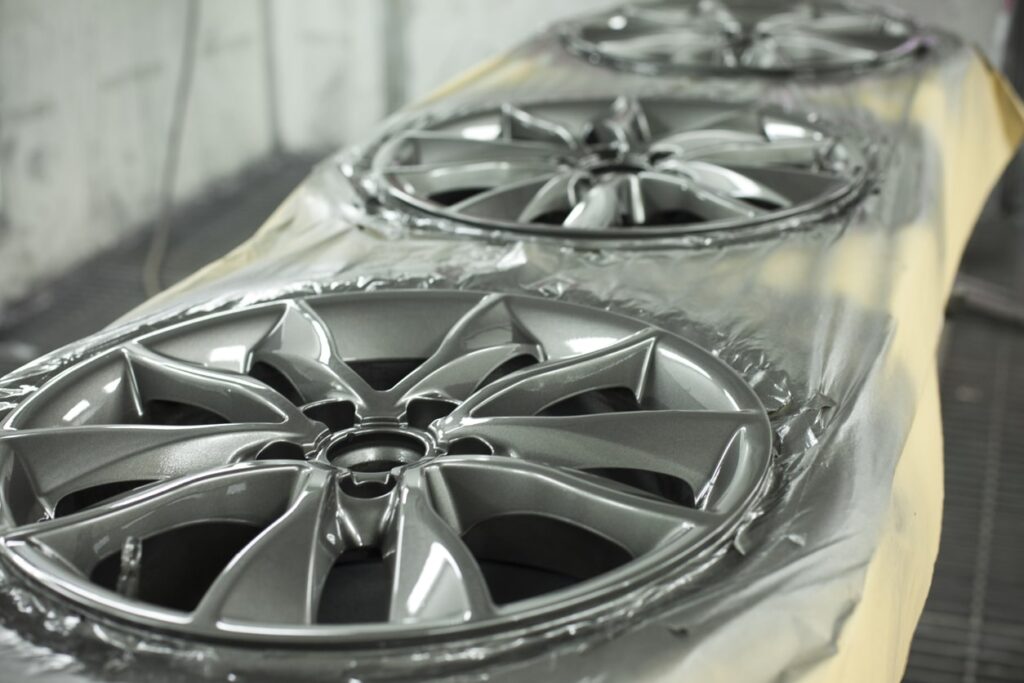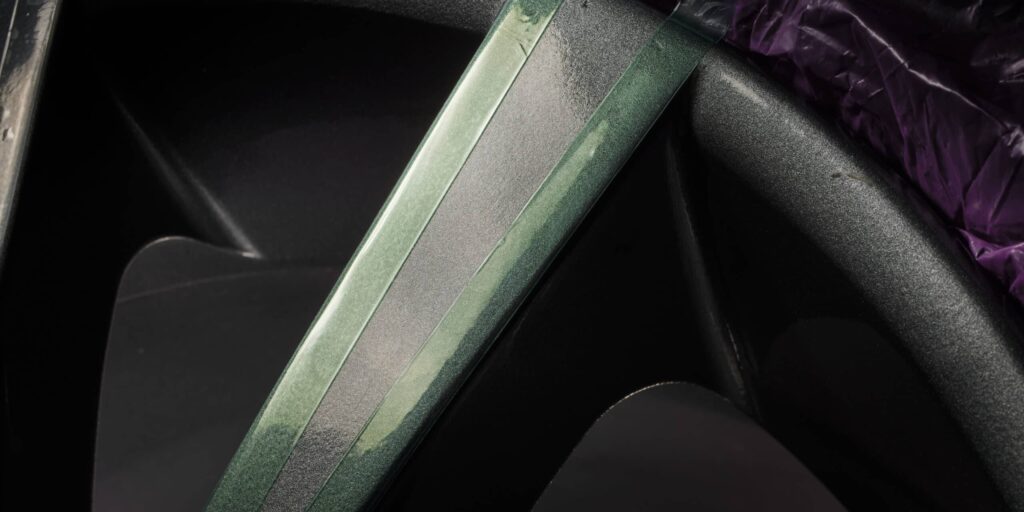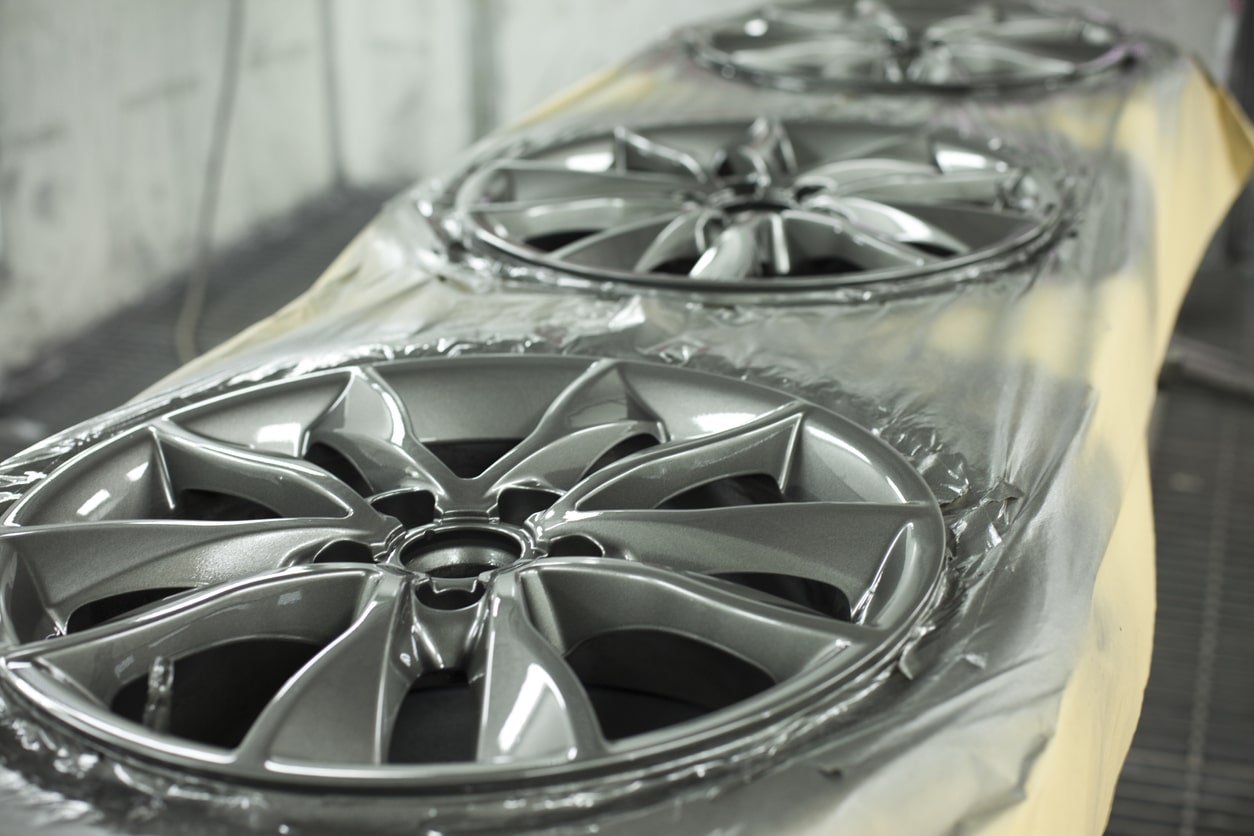When customers are looking to restore their car to its old glory, they can sometimes focus too much on the paintwork – and that’s understandable, it covers a large surface area, and it’s the place that people tend to focus on when buying a new car.
It’s crucial, though, not to neglect the alloy wheels. They’re a big part of a car’s overall look, but they do require specialist equipment and training to restore.
Part of this restoration is the powder coating process, which involves covering the surface of your rims with a dry polymer-based powder mixed with curing additives, levelling agents, resin, flow modifiers, and pigments.
The powder blend bonds to an electrostatically charged surface, and this is heat-cured in an oven or kiln. Under the heat, the powder melts and coats the wheels evenly. As the alloys are removed and cool off, the surface hardens and becomes smooth.

How to powder coat alloy wheels: Step-by-step
Below, we’ll take you through the step-by-step process for applying alloy wheel powder coating to a professional standard.
The preparation stage is arguably the most important. Without proper prep work, it can be tricky to achieve a high-quality finish, which can also affect durability.
1. Remove wheels
Since powder coating is a full refurbishment and requires exposure to high temperatures, it’s recommended that you remove the entire wheel rather than attempting to work on the wheel while it’s still attached to the axle.
2. Ensure wheels are cleaned and free of imperfections
From there, you should ensure that the wheel is clean and free of any imperfections. To do this, a specialist alloy wheel cleaner and sandblaster are usually required.
After sanding any abrasions or curb damage on the surface of the alloys, they should then be heated in an industrial oven or kiln to release any gases that could cause problems.
3. Mask wheels where required
Before beginning the next stage, it can be helpful to have high-temperature film tape on hand since powder coating involves working at high temperatures. These can work well for marking off the various edges and curves of alloy wheels while protecting them from heat damage.
High-temperature polyester film discs can also be useful for masking off the back of the wheel hub during the powder coating process. Taping can add the level of precision you’re looking for as a professional, and having the right tapes available can make a huge difference to the overall appearance.
4. Spray the base coat
The alloy wheel is suspended in the paint booth, electrically charged, and sprayed with the base layer to create a smooth foundation layer. Ensure you use enough powder, since too little or too much can adjust the cure times and cause under- and over-curing.
It should then be placed back into the oven for around 20 minutes or until the powder begins to spread as a gel-like consistency as it adheres across the surface.
5. Add the clear powder coat
After the alloys have been removed from the oven and cooled to room temperature, they can be returned to the painting booth for the clear coat. This is applied using the exact same method as for the base coat, although it will appear white before being baked.
6. Bake the clear coat
The final coat is returned to the oven or kiln to bake for around 40 minutes. This process is often referred to as heat treating.
Once the alloy is completely cooled, you can remove any hooks, tape, or centre plugs before re-fitting the wheels. You can also check the quality at this stage to make sure the customer is getting exactly what they wanted.
Types of powder coatings
Powder coatings come in various forms that can be used to achieve the perfect finish for customers. As a professional alloy wheel repair technician, it’s your job to weigh up the pros and cons of each type of powder coating and decide which will deliver the best final result, while listening to the customer’s requests. For example, some powder coatings can be more difficult to maintain than others. Body shop professionals should work with customers to find their perfect colour and finish.
Brighter colours can add a pop to the car’s appearance, but these can collect tar and dirt from the road that dulls their appearance over time. Similar issues can arise with matte finishes since car owners often struggle to keep these clean.
Darker colours with satin or high gloss finishes are among the most common options since these can conceal dirt, debris, and minor surface flaws better. Although some will opt for a more bespoke finish, which can include bright glitters or multiple colours mixed.
Epoxies are very tough with the best corrosion resistance, but they fade fast outdoors because of their poor UV resistance, so they’re best used as primers. Hybrids, epoxy and polyester are sometimes used to improve smoothness, but again, they don’t perform well outdoors.
Polyesters are great all-rounders; they’re affordable, flexible, with lots of finish options. Standard types work indoors and short-term outdoors, while super durable polyesters can last up to 10 years.
Fluoropolymers are the premium option, offering unmatched weather, colour, and gloss retention (up to 20 years), but are costly and specialised. Urethanes give a very smooth, durable finish with strong chemical resistance, making them the perfect material for use on alloy wheels, but they do cost considerably more and require careful application.

Benefits of powder coating wheels
Why do car owners choose powder coating for their alloy wheels? Below, we’ll go through some of its pros.
- Improved resistance & durability: The powder coating provides a thick, consistent layer of coverage for the alloys, which helps them last longer. When finished to a high standard, alloy powder coating should easily last between 15-20 years. The non-porous surface also provides better protection against common issues like chipping, flaking, or corrosion.
- Cost efficiency: Although the initial cost can often be more than regular paint, the lack of maintenance required can save money for car owners in the long run.
- Better coverage than regular paint: Alloys often have intricate details that can be difficult and time-consuming to paint. Using this method, customers can rest assured knowing that every bit of their alloy is evenly covered.
- Works with any metal: Regardless of whether the alloys are brass, stainless, steel or aluminium – powder coating can be applied on any metal surface.
We hope this guide gives you the confidence and knowledge necessary to powder coat alloys to a professional standard. Whether you’re a beginner or just need a reminder of the most up-to-date techniques, our experts have got you covered.
For more information about our full range of innovative JTAPE products suitable for use in body shops, please visit our online store, or contact us to find your local distributor.
